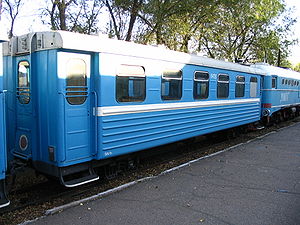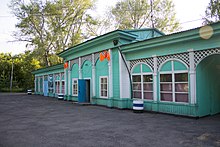Karaganda Children's Railway
| Karaganda Children's Railway | |
|---|---|
|
PV40 car and diesel locomotive TU2 -111
| |
| Route length: | 5.1 km |
| Gauge : | 750 mm ( narrow gauge ) |
The children's railway Karaganda ( Russian Карагандинская детская железная дорога , Karagandinskaja detskaja schelesnaja doroga ) is a narrow-gauge miniature railway in Karaganda (or Karaganda) in Kazakhstan . The line with a track width of 750 millimeters has a length of 5.1 kilometers. It has two wooden station buildings. The line was opened on May 1, 1957 as one of the many pioneer railroads in the Soviet Union and was temporarily out of service in 2001-2004 and 2006-2007. In July 2007, May 2008 and August 2009 it was back in operation.
history
On August 22, 1956, Miner's Day , several test drives were carried out on the originally 1.8-kilometer route, but regular operations did not begin until May 1, 1957. Initially, the locomotives in the two-track Pionerskaya station were moved to the other end of the train, but there was a loop at Komsomolskaya station . Wooden station buildings stood at both ends of the line. That of Komsomolskaya still survives, but that of Pionerskaya only existed until the late 1960s or early 1970s. Now there is only the stationmaster's small brick building.
In the steam locomotive era, the train consisted of three light wooden wagons no more than seven to eight meters in length. Probably in the mid-1960s, they were replaced by all-metal passenger cars from an unknown manufacturer, and later by three cars from the Polish PAFAWAG . Around 1990 the five local wagons were replaced by three longer Polish wagons and the platforms were lengthened accordingly.
In the course of the renovation of the tracks, the signaling system was also modernized. In the 1990s, Komsomolskaya Station was renamed Arman, and Pionerskaya Station, which was relocated to a new location, was named Druzhba.
Like many other former pioneer railways in Kazakhstan, the Karaganda children's railway threatened to fail due to financial problems in the late 1990s. In the winter of 2000 the state railway company of Kazakhstan Temir Scholy informed the management of the children's railway about the impending termination of the financing. After the management of the Ispat-Karmet (Испат-Кармет), the successor to the Karaganda smelting works combine (Карагандинский металлургический комбинат), which had its own locomotive and wagon fleet of its own, had heard of the wish to have its own locomotive and wagon fleet again . Unexpectedly, the management of the state railway company then approved the necessary funds for the necessary repairs to the vehicles and the infrastructure of the children's railway.
The 2001 season passed without any problems. In order to increase sales, a wedding train was even introduced, like the Qostanai Children's Railway (Кустанайской ДЖД). Nevertheless, the children's railway could not be operated profitably, so that the management of the state railway company stopped financing the children's railway. In November 2001, almost the entire staff of the children's railway was dismissed and their boss was transferred to security duty. The children's railway was assigned to a subsidiary by the Kazakhstani state railway company Temir Scholy and put up for sale one year later. There were fears that the children's train would be sold or scrapped. In the summer of 2004, the local council of elders asked the provincial government to restore the children's railway. After long arguments, the state railway company was persuaded to repair the children's railway again. On August 1, 2004, it was then reopened to passenger traffic. At the end of December 2004 it was transferred free of charge to the Administration of the Parks of Culture and Recreation. Since then, the city budget has provided money for its maintenance.
Because no sufficiently qualified young people could be found to operate the railway after several years of downtime, it was operated by adults in the summer of 2004. It is difficult for the Karaganda Provincial Government to maintain the route at its own expense without support from the state railway company. In 2006 and the first half of 2007, the children's railway could therefore not be operated. The line was damaged in some places during the laying of pipelines, but in July 2007 both the line and the rolling stock were repaired and operations resumed by adults, albeit without the task of training future railway workers.
Rail vehicles
At first there was a WP1-805-27 steam locomotive, which, due to the unusual numbering, had probably been used on a works railway . In 1961 at the latest, the children's railway received the TU2-115 diesel locomotive. The TU2-037 diesel locomotive was procured in the early 1970s. This was sent for a general overhaul in 1987–1989, and in return the children's railway received a TU2 -111 diesel locomotive from the Qostanai children's railway, which is still in operation. There were also three wooden wagons and at least three unknown types of metal made wagons, as well as three Pafawag wagons imported from Poland .
Web links
Individual evidence
- ↑ a b c d e f g Дмитрий Сутягин (Dmitry Sutyagin): Детские железные дороги СССР - История и современность: Караганда. 2000-2015. Retrieved November 12, 2017.
- ↑ a b c Наталья Фомина: Опять по шпалам. Retrieved November 12, 2017.
- ↑ С. Болашенко: КАРАГАНДИНСКАЯ ДЕТСКАЯ ЖЕЛЕЗНАЯ ДОРОГА. Retrieved November 12, 2017.
Coordinates: 49 ° 48 ′ 0 ″ N , 73 ° 4 ′ 30 ″ E



